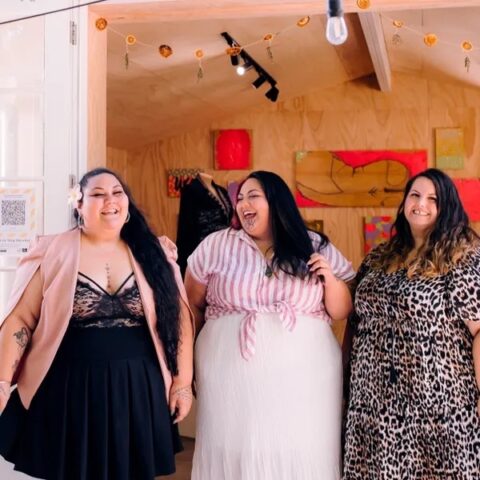The relationship people have with their bodies is complicated. Here’s why the body neutrality movement is shifting the focus away from appearance.
From tabloid media to gym changing rooms, constant negative comments about women’s bodies are long gone. These days, it’s more common to talk about bodies in a positive light rather than the go-to body-shaming discourse of the old days.
And this shift isn’t just on a personal level. Clothing labels have started to include a more diverse range of body types in their ads and sports brands. Nike has started making activewear for bigger sizes, proving the point that exercise isn’t about looking a certain way.
Plus-size models like Ashley Graham and Tess Holliday are extremely successful, and musician Lizzo became a face of the body-positivity movement thanks to her upbeat songs that celebrate women of all sizes.
But recently, Lizzo came under major fire for charting her weight loss while on a 10-day smoothie detox. Fans criticised her for promoting an unsafe diet culture that is in complete contradiction to her usually body-positive rhetoric. One commenter wrote, “Always so disheartening to see someone that you thought was a champion for all bodies and self-love give in to the toxicity of diet culture.”
The backlash was so loud, it prompted the artist to respond in a series of videos.
“I would normally be so afraid and ashamed to post things like this online,” she said, “because I feel like, as a big girl, people just expect if you are doing something for health, you’re doing it for a dramatic weight loss, and that is not the case.”
Lizzo went on to explain that, after a stressful November in which she “drank a lot [and] ate a lot of spicy things”, she embarked on the detox to try to “reverse it and get back to where I was”.
Her response seemed to set the record straight, and the singer also pointed out that “every big girl should do whatever the f*** they want with their bodies”.
But in the wake of the furore, some very real limitations of the feel-good, love-yourself body-positive culture were exposed. One such limitation, critics have said, is that “body positivity” has become so relentlessly commercialised that people now feel guilty for not absolutely loving the way they look. Although there’s a wider definition of “beautiful” than yesteryear, an extreme focus on aesthetics and appearance makes it hard for some women to truly embrace the purpose that the body- positive movement initially started out with: true liberation from restrictive beauty ideals.
The simple issue is that it’s unrealistic to adore what you see in the mirror every single day. Some days are just not good days – and that’s okay. So what to do? Scrap body positivity altogether? Surely, a step back into the negative isn’t the answer.
While there is no perfect solution, a form of self-love called “body neutrality” could help. Essentially, body neutrality shifts the focus from “negative” and “positive” by thinking less about how your body looks and more on what it does, effectively neutralising your mindset. For example, your body lets you exercise, it lets you hold hands and hug your loved ones, it takes you places.
The main tenet of body neutrality is that loving your body isn’t always achievable. Some days you love it, some days you hate it, and some days it’s just…neutral.

Self-love through this lens is realising that when you treat your body with care, it can help you do and feel things that make you happy. Treating yourself well means nourishing it, giving it the things it needs – and also what it wants.
Furthermore, instead of pursuing health because you’re attached to how it makes you look, body neutrality prioritises the feeling of being healthy through exercise, such as yoga, going to the gym, walking or dancing. The same goes for your approach to food. Eating in abundance and letting yourself enjoy so-called indulgent things is an act of self-love.
In a world of selfies and Zoom meetings, it’s easy to devote a lot of time to thinking about appearance. But it can too easily lead to obsessing and a silent self-criticism that takes up a massive amount of mental energy. Sadly, almost everyone knows the feeling of being so self-conscious and hung up on how you look that you’re not actually present in the moment. These types of preoccupations can lead to increased anxiety, low self-esteem and feelings of being out of control.
At its core, body neutrality is about being. The perks of adopting this mindset are that you spend less time self-criticising and more time practising acceptance and allowing yourself to show up in the present. Simply being who you are without passing judgement or having strong emotions attached to how you look means freedom from restrictive or crippling thought patterns about your body.
This, of course, is easier said than done. The journey to becoming body neutral is difficult when the commentary around women’s bodies – regardless of how much the conversation has shifted – still focuses on how we look in relation to an established set of beauty standards.
So how do we go about starting on this path to greater body freedom? An effective approach is similar to a technique for coping with anxiety. When a negative thought about your body pops into your head, acknowledge the thought and shift it back to a neutral mindset.
For example, you may look at your thighs and think, “Oh, god, they’re so big. I hate them!” But if you look at it from a body-neutral perspective, you can acknowledge the strength and the power of those very legs, then also acknowledge the rest of your body – the power and function of the hands and arms, the consistent, hard work of the heart and the lungs, the wonder of the brain.
Our relationships with our bodies will never be simple – everyone has their own very personal, historical and complicated experience. But embracing body neutrality might be a way we can shift our focus from looks and outward appearance to appreciating and treating our bodies like the amazing things they are.
Steps to becoming body neutral
- Notice negative self-talk about your body.
- Identify and acknowledge it without judgement.
- Counteract the negative self-talk with neutral phrases – for example: “Thank you body, for taking care of me today.”
- Acknowledge your other strengths and talents. What are you good at? What makes you unique?
- Clean up your social media feeds by unfollowing accounts that make you feel bad about yourself.








